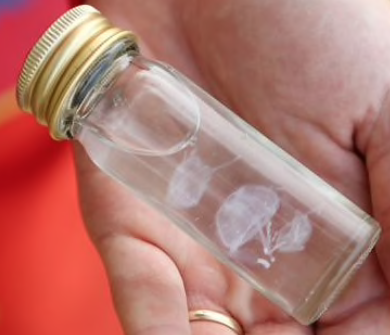The Mysterious Symptoms Of A Tiny Box Jellyfish - Irukandji Syndrome In South-East Asia?
"Scientists have now also discovered that other species of jellyfish, most notably other cubozoans or box jellyfish (of which Irukandji is one of the smallest) also give rise to this syndrome. There are at least 8–12 other species of Irukandji jellyfish found in Australian waters. Most have been documented in the warmer waters of the east coast. Research has revealed that they also like to extend their tentacles and have caused injury in other parts of the world. Unfortunately there are no definitive tests that can confirm if patients are the victims of Irukandji stings. Treatment of the cryptic syndrome is also complex due to the varying symptoms, so it’s easy to misdiagnose."
- Australian Geographic
If you've ever inexplicably felt like hell some time after emerging from the sea in South-East Asia and more than likely went to hospital where you could not get any relief from medication, comfort from loved ones and an explanation from doctors, a box jellyfish sting and Irukandji Syndrome may, just may, have been the cause of your woes.
As box jellyfish researcher Professor Jamie Seymour described in Australian Geographic, "It sneaks up to suddenly slap you in the face. Then you experience nausea and breathing difficulties, and your entire body becomes riddled with pain. It feels, he says, like having an elephant sitting on your chest and you experience a sense of impending doom. Other symptoms include vomiting, severe headaches, fluid in the lungs, cardiac failure and a severe rise in blood pressure, ultimately resulting in death in some cases."
Irukandji Syndrome as you can gather is deadly serious. While commonly associated with tropical northern Australia, there have been reports in the past of similar symptoms experienced by swimmers, snorkelers, divers, fishermen and other seawater users in South-East Asia, and all without explanation.
The Morbakka box jellyfish is probably the most common cubozoan stinger in the region and when it does, the pain is instant and severe while the large, whiplash-like lesions left on the skin are a telltale sign of its savage potency.
It does, however, seem also to induce a kind of Irukandji Syndrome with some victims experiencing a number of these symptoms from headaches, nausea and vomiting to breathing difficulties and excruciating back pain.
The most venomous of box jellyfish in Thailand, Malaysia, the Philippines and a number of their neighbours is the Chironex species. These animals are killers. Survivors speak of lingering symptoms associated with a severely weakened immune system, though the unimaginable pain from the sting soon dissipates and there are no other known symptoms aside from skin necrosis and secondary infection with nothing comparing to Irukandji Syndrome.
There are many other types of harmless, mildly venomous and seriously venomous box jellyfish to be found in the seas of South-East Asia. But, there are believed to more that have gone undetected and of course have yet to be discovered. Scientists here are still learning about those they know about and some are refusing, are unable to or are prevented from even acknowledging that these creatures or others like them exist.
The Irukandji jellyfish is minuscule. Transparent, unpredictable and somewhere in size around 10 to 25mm. Its highly toxic sting is hardly discernible and more resembles a mosquito or spider bite. Most do not even know they've been stung. Also commonly in Australia, the presence of salps is a high indication of the presence of Irukandji.
With all of the knowledge, expertise and resources available to them, Australian marine scientists - that helped take Thailand in 2009 from no awareness of Chironex box jellyfish to the regional leader in prevention and treatment - are only now after some 70 years of acknowledgment of the species and decades of research learning firsthand about Irukandji reproduction through a breeding in captivity program.
Read The Full Australian Geographic Story:
South-East Asia is light years behind. Could there be a type of Irukandji in this region? Scientists from outside think that it is not only possible, it is definitely the case, but without access or collaboration are unable to back up these views with cold, hard scientific evidence.
Anecdotally, the evidence is strong. Cases presented to hospitals and medical clinics and commented on through social media platforms speak of strange, debilitating and dangerous symptoms.
One such example occurred while filming the Swedish version of the series Survivor in Malaysia where after jellyfish were spotted at the beach, a contestant who had been swimming felt extreme pain with muscle cramps, aching, sweating, nausea and excrutiating skin.
And, here is another reported by a highly distressed family who were holidaying on Langkawi. The young female victim suffered ongoing symptoms including delirium, insomnia, lethargy, vomiting, restlessness, severe headache, intense body pain and dangerously high blood pressure.
To quote the Australian Geographic article again, "... there are no definitive tests that can confirm if patients are the victims of Irukandji stings. Treatment of the cryptic syndrome is also complex due to the varying symptoms, so it’s easy to misdiagnose."
An apparent heart attack? A perceived drowning? Alleged drunkeness or illicit drug use? A panic attack? A list of other causes to explain Irukandji Syndrome-like symptoms and the possible deadly result of a sting is probably exhaustive. It could be anything.
Sometimes, as has occurred in the past, it's a case of what you don't know won't hurt you and there is too much at stake to even start looking. Whether a species much like Irukandji exists or not in South-East Asian waters, it's incumbent on medical health services and the marine science community to be vigilant, open minded and diligent in their investigations and assessments. The truth is out there somewhere.
Photo credit Cairns Post/Josh Woning




Comments
Post a Comment